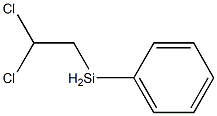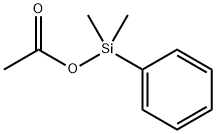Ethylphenyldichlorosilane
- CAS NO.:1125-27-5
- Empirical Formula: C8H10Cl2Si
- Molecular Weight: 205.16
- MDL number: MFCD00053199
- EINECS: 214-407-8
- SAFETY DATA SHEET (SDS)
- Update Date: 2024-12-18 14:15:32

What is Ethylphenyldichlorosilane?
Chemical properties
Colorless liquid that fumes strongly in moist air.
Chemical properties
Ethyl phenyl dichlorosilane is a colorless liquid. Fumes in humid air.
General Description
Ethylphenyldichlorosilane is a colorless liquid with a pungent odor. Ethylphenyldichlorosilane is decomposed by water to hydrochloric acid with evolution of heat. Ethylphenyldichlorosilane is corrosive to metals and tissue.
Air & Water Reactions
Reacts vigorously with water to form hydrogen chloride(hydrochloric acid)
Reactivity Profile
Chlorosilanes, such as Ethylphenyldichlorosilane, are compounds in which silicon is bonded to from one to four chlorine atoms with other bonds to hydrogen and/or alkyl groups. Chlorosilanes react with water, moist air, or steam to produce heat and toxic, corrosive fumes of hydrogen chloride. They may also produce flammable gaseous H2. They can serve as chlorination agents. Chlorosilanes react vigorously with both organic and inorganic acids and with bases to generate toxic or flammable gases. Special Hazards of Combustion Products: Toxic hydrogen chloride and phosgene fumes may be formed.
Hazard
Toxic by inhalation and ingestion, strong irritant to eyes and skin.
Health Hazard
Inhalation irritates nose and throat. Contact with liquid causes severe burns of eyes and skin. Ingestion causes severe burns of mouth and stomach.
Safety Profile
Poison by ingestion and inhalation. A poison irritant to skin, eyes, and mucous membranes. Corrosive. Will react with water or steam to produce toxic and corrosive fumes. Can react with oxidizing materials. When heated to decomposition it emits toxic fumes of Cl and phenol. See also CHLOROSILANES.
Potential Exposure
Used in the manufacture of silicone polymers
Shipping
UN2435 Ethylphenyldichlorosilane, Hazard class: 8; Labels: 8-Corrosive material.
Incompatibilities
A strong reducing agent. Incompatible with oxidizers (chlorates, nitrates, peroxides, permanganates, perchlorates, chlorine, bromine, fluorine, etc.); contact may cause fires or explosions. Keep away from alkaline materials, strong bases, strong acids, oxoacids, and epoxides. Chlorosilanes react vigorously with bases and both organic and inorganic acids generating toxic and/or flammable gases. Chlorosilanes react with water, moist air, or steam to produce heat and toxic, corrosive fumes of hydrogen chloride. They may also produce flammable gaseous hydrogen. Attacks human tissue and metals in the presence of moisture
Properties of Ethylphenyldichlorosilane
| Boiling point: | 225-6°C |
| Density | 1.184 |
| refractive index | 1.5321 |
| Flash point: | 92°C |
| Specific Gravity | 1.184 |
| Hydrolytic Sensitivity | 8: reacts rapidly with moisture, water, protic solvents |
| EPA Substance Registry System | Benzene, (dichloroethylsilyl)- (1125-27-5) |
Safety information for Ethylphenyldichlorosilane
Computed Descriptors for Ethylphenyldichlorosilane
New Products
(S)-3-Aminobutanenitrile hydrochloride 4-Methylphenylacetic acid N-Boc-D-alaninol N-BOC-D/L-ALANINOL Tert-butyl bis(2-chloroethyl)carbamate 3-Morpholino-1-(4-nitrophenyl)-5,6-dihydropyridin- 2(1H)-one Furan-2,5-Dicarboxylic Acid Tropic acid 1-Bromo-3,5-Di-Tert-Butylbenzene S-2-CHLORO PROPIONIC ACID ETHYL ISOCYANOACETATE 2-Bromo-1,3-Bis(Dimethylamino)Trimethinium Hexafluorophosphate 4-IODO BENZOIC ACID 3-NITRO-2-METHYL ANILINE 1-(2,4-DICHLOROPHENYL) ETHANAMINE (2-Hydroxyphenyl)acetonitrile 4-Bromopyrazole 2-(Cyanocyclohexyl)acetic acid 4-methoxy-3,5-dinitropyridine 1-(4-(aminomethyl)benzyl)urea hydrochloride 2-aminopropyl benzoate hydrochloride diethyl 2-(2-((tertbutoxycarbonyl)amino) ethyl)malonate tert-butyl 4- (ureidomethyl)benzylcarbamate Ethyl-2-chloro((4-methoxyphenyl)hydrazono)acetateRelated products of tetrahydrofuran








You may like
-
 2033-24-1 98%View Details
2033-24-1 98%View Details
2033-24-1 -
 42831-50-5 5-METHYLISOXAZOLE-4-CARBOXYLIC ACID 98%View Details
42831-50-5 5-METHYLISOXAZOLE-4-CARBOXYLIC ACID 98%View Details
42831-50-5 -
 1975-50-4 98%View Details
1975-50-4 98%View Details
1975-50-4 -
 2-HYDROXY BENZYL ALCOHOL 98%View Details
2-HYDROXY BENZYL ALCOHOL 98%View Details
90-01-7 -
 2-Chloro-1,3-Bis(Dimethylamino)Trimethinium Hexafluorophosphate 221615-75-4 98%View Details
2-Chloro-1,3-Bis(Dimethylamino)Trimethinium Hexafluorophosphate 221615-75-4 98%View Details
221615-75-4 -
 61397-56-6 CIS BROMO BENZOATE 98%View Details
61397-56-6 CIS BROMO BENZOATE 98%View Details
61397-56-6 -
 14714-50-2 (2-Hydroxyphenyl)acetonitrile 98+View Details
14714-50-2 (2-Hydroxyphenyl)acetonitrile 98+View Details
14714-50-2 -
 118753-70-1 98+View Details
118753-70-1 98+View Details
118753-70-1